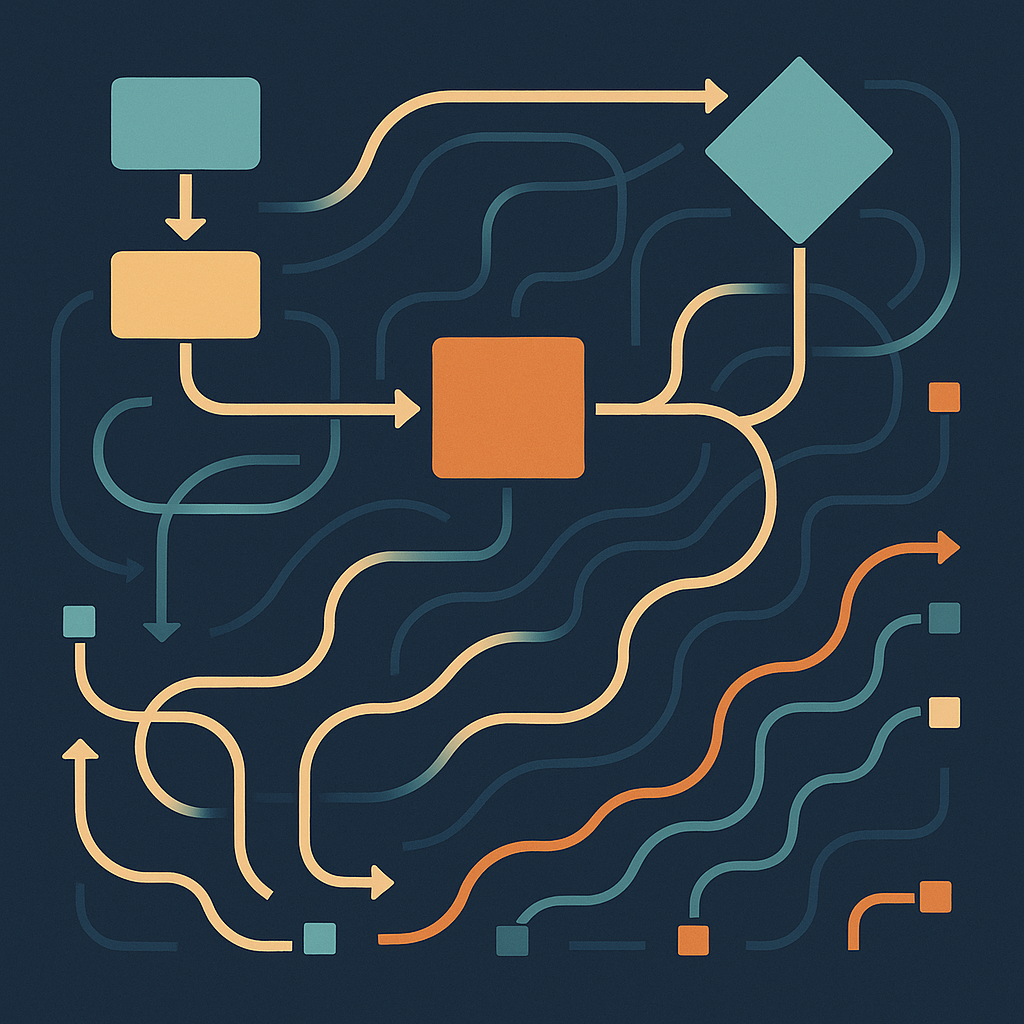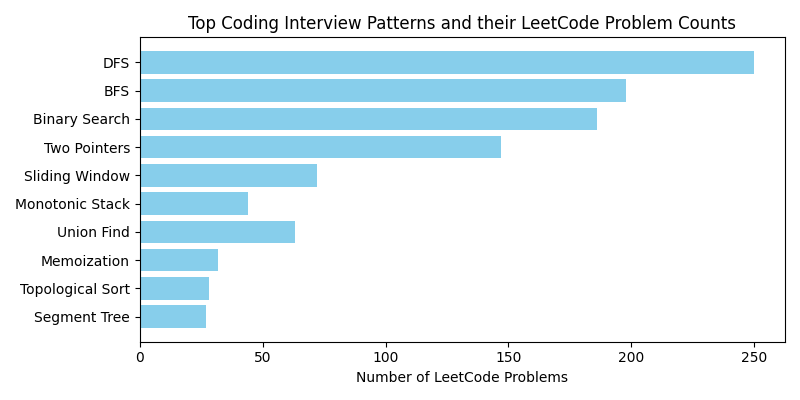How I Prepared for LeetCode Interviews

Preparing for a software engineering interview can feel overwhelming LeetCode alone has more than two thousand problems across data structures, algorithmic techniques and coding patterns.
Instead of randomly grinding hundreds of problems, I focused on pattern‑based practice and was able to get interview‑ready in about two to three months.
This post lays out my approach including the study timeline, weekly and daily routines, resources, notes system, common pitfalls and tips for the final weeks.
It combines lessons from my own experience with research from reputable interview preparation guides and articles.
Why Patterns Matter
Interview questions are seldom unique puzzles; they are variations of recurring patterns.
The creators of Grokking the Coding Interview note that modern coding interviews have become more competitive, and the key skill that helped them prepare was the ability to map a new problem to an already known problem.
Their course compiles 33 common coding patterns so that once you are familiar with a pattern, you can solve dozens of problems with it.
Other experts echo this advice. A article stresses that mastering patterns allows you to study smarter, rather than spending months grinding problems.
Arslan Ahmad’s series on coding patterns explains that these patterns are recurring techniques—building blocks of algorithms that help you break down complex problems into manageable parts. He highlights that you don’t need to solve 500+ LeetCode problems; instead, you need to master a handful of high‑impact patterns.
Examples of High‑ROI Patterns
The chart below summarizes some of the highest‑ROI coding patterns according to data from the DesignGurus blog. These counts reflect the number of LeetCode problems tagged with each pattern and show why patterns like Depth‑First Search, Breadth‑First Search, Binary Search and Two Pointers are worth mastering.

Resources I Used
To structure my study, I relied heavily on two complementary courses:
- Grokking the Coding Interview – This course systematically teaches patterns such as two pointers, sliding window, fast and slow pointers, merge intervals, cyclic sort, BFS/DFS on graphs and trees, backtracking, topological sort, dynamic programming and more. It emphasizes mapping new problems to known templates and includes hundreds of practice problems.
- AlgoMonster – A pattern‑oriented prep site that provides visual explanations and targeted drills by topic. I completed both courses (100 % completion for each), which gave me deep familiarity with common patterns.
In addition, I skimmed LeetCode discuss threads and company‑tagged questions for variants, used editorial solutions to compare approaches, and occasionally referenced other blogs and cheat sheets when I encountered new patterns.
Topics Covered
By the end of my core study phase, I had covered patterns involving:
- sliding window
- two pointers / fast & slow pointers
- heaps and priority queues
- binary search and search‑on‑answer
- depth‑first search (DFS) & breadth‑first search (BFS) on trees and graphs
- backtracking and recursion
- topological sort
- dynamic programming (1‑D & 2‑D)
- interval and merge problems
- bit manipulation
- prefix/suffix arrays
- tries and union‑find
Study Timeline
I broke my preparation into three major phases. The following timeline outlines what I did and when:
- Month 1 – Core patterns. I dedicated daily practice to learning patterns. After about three weeks (around week 3), I began applying for jobs while still studying.
- Weeks 5–8 – Timed practice & finishing remaining patterns. I completed the remaining patterns and began doing timed sets. For any scheduled interviews, I started company‑specific prep.
- Weeks 6–9 – Interviews. By the time my interviews began, I had either finished or was close to completing all patterns in Grokking and AlgoMonster.
While my timeline spanned about 1.5–2 months, a more general guide from recommends budgeting about three months with ~11 hours per week for a holistic preparation【445053179052730†L74-L78】. Choose the timeline that fits your schedule, but prioritize consistent practice.
Weekly Plan for Pattern‑Based LeetCode Practice
Each week I aimed for 12–15 hours of focused practice (roughly 2–3 hours per day on weekdays). My weekly routine consisted of four components:
- Learn (30–45 min). Read a pattern chapter from Grokking or the equivalent section in AlgoMonster. Understand the template and when to apply it.
- Drill (60–90 min). Solve 3–5 problems: start with an easy problem to warm up, then two medium problems, and optionally a hard one. Force yourself to code from scratch and aim to finish medium problems in 25–35 minutes.
- Review & Retrospective (20–30 min). Compare your solution to the editorial or course template. Note the trigger that reveals the pattern (e.g., “fixed‑size subarray → sliding window”) and capture a concise template and checklist.
- Spaced Repetition (10–20 min). Revisit 2–3 previously missed problems 48–72 hours later. Tracking how long it takes to solve a problem again helps you gauge retention and speed.
Tip: Track metrics like minutes per problem, number of attempts to reach accepted (AC), and whether you recognized the pattern within two to three minutes. These metrics reveal progress and highlight patterns that need more practice.
Daily Checklist
To stay disciplined during each practice session, I used a simple checklist:
- Identify the pattern. Spend the first 2–3 minutes asking yourself: Is this a sliding window? Two pointers? Monotonic stack? Heap? Graph? Recognizing the correct pattern early is crucial.
- State constraints and edge cases. Clarify input size, data type and any special cases. If a problem description seems ambiguous, practice paraphrasing and asking clarifying questions—just like you would in an interview【9623031470631†L154-L168】.
- Write pseudocode quickly. Draft pseudocode within 1–2 minutes. This helps you outline the algorithm before diving into syntax.
- Implement from scratch. Code the solution and dry‑run with a tricky test case.
- Check complexity. Evaluate time and space complexity and decide whether micro‑optimization is necessary.
Company‑Specific Phase
Once I had scheduled interviews, I switched to targeted practice:
- Pull company‑tagged LeetCode questions. Candidates on Glassdoor recommend practicing problems tagged for a specific company, such as Google‑tagged problems in the medium and difficult ranges. This helps you become familiar with the style and difficulty the company prefers.
- Complete 10–20 targeted problems per company. Time yourself and simulate interview conditions. Keep practicing patterns but adapt them to each company’s favorite topics.
- Practice verbalizing your thought process. One of the hardest parts of a coding interview is communicating what you are doing while you are doing it. To prepare, I practiced restating the problem, discussing trade‑offs and complexity out loud, even when coding alone.
- Do mock interviews. IGotAnOffer’s guide suggests doing mock interviews and warns against letting the first real interview be your first attempt. Practicing with peers or coaches helps you get feedback on both problem‑solving and communication.
Minimal Notes System
To reinforce patterns without creating an overwhelming knowledge base, I kept my notes lean:
- Pattern cards. I created one card per pattern detailing when to use it, a short template and common pitfalls. Each card included one or two canonical examples.
- Miss log. For every problem I failed on the first attempt, I recorded the problem, why I missed it, the trigger I should have recognized, and the corrected template. I reviewed the pattern cards and miss log two to three times per week to reinforce learning.
Final 1–2 Weeks Before Interviews
In the last couple of weeks, I shifted from learning to polishing:
- Mixed timed sets. Rotate timed sets of two medium questions plus one hard question, aiming to complete all three within 75 minutes.
- Mock interviews. Schedule at least two mock interviews per week. Practicing under pressure improves your ability to think, code and communicate simultaneously.
- Behavioral preparation. Develop STAR stories (Situation, Task, Action, Result) and prepare 5–7 examples that demonstrate impact, conflict resolution, leadership and failure. Behavioral questions matter as much as technical skills.
- Light system design. If your role requires system design, review high‑level patterns and practice drawing out API and data models. Grokking the System Design Interview is a good starting point, but you don’t need to complete the entire course—focus on understanding the framework and practicing a few whiteboard sessions.
Common Pitfalls and How to Avoid Them
Based on my experience and advice from experts, here are some traps to watch out for:
| Pitfall | Fix | Over‑grinding random LeetCode problems | Start with pattern coverage. Focus on one pattern at a time and use spaced repetition to make it stick. Once you’ve mastered patterns, you can explore random problems for variety. | | Reading solutions too early | Struggle on a problem for 20–25 minutes. Only then read the solution, and re‑implement it from memory later. Going back and solving missed problems from memory solidifies the pattern. | | Not tracking time | Interviews are timed; practice that way. Use a timer and gradually reduce your allowed time to mimic interview conditions. | | Neglecting communication | Don’t code silently. The recommends explaining your approach before coding, describing what you’re doing as you code, and checking for mistakes while talking through your thought process. Communicate trade‑offs and ask clarifying questions. |
Optional Add‑Ons
To mix things up and keep practice engaging, consider the following extras:
- Speed‑run day: Solve 10 easy/medium problems in 2–3 hours to strengthen pattern recognition under time pressure.
- One‑pattern day: Spend a day solving variants of a single pattern (e.g., all sliding window problems). This deepens intuition and helps you see nuanced variations.
- Post‑mortem document: After each interview, jot down 5 bullets on what went well and what didn’t. Address any gaps within 48 hours while the experience is fresh.
Results & Recommendation
Following this pattern‑centric study plan, I felt interview‑ready after 1.5–2 months of consistent practice. When interviews rolled around, I had completed 100 % of both Grokking and AlgoMonster courses, which gave me a robust pattern repertoire. By switching to company‑specific questions for each interview and practicing my communication, I was able to pass coding rounds reliably.
If you have more time, consider following the three‑month study plan (11 hours/week). Regardless of your timeline, a structured approach centred on patterns, deliberate practice, tracking progress and clear communication will significantly boost your performance in technical interviews.
Happy coding and may your next LeetCode session be one step closer to your dream job!